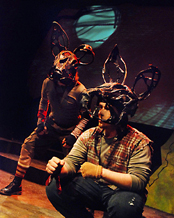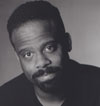From Time Out Chicago
May 11, 2011
By John Beer
FOUR STARS
The most rousing adventure story on a Chicago stage at the moment may well involve rabbits. Hildreth’s adaptation of Adams’s 1974 leporine epic skillfully distills the story of Fiver ([S. Thomasin Barsotti]), Hazel (Paul S. Holmquist) and the rest of their ragtag band, who narrowly escape the destruction of their warren by a real estate development. As the rabbits make their way to the promised land of Watership Down, their encounters with predators, rivers and rival warrens are sketched at a breathless clip, though Hildreth also makes room for the mythic exploits of the trickster bunny progenitor El-ahrairah (Holmquist).
While watching a dozen actors pretend to scratch and hop about for a couple of hours might chill the heart of the most stalwart theatergoer, Lifeline’s physically adept ensemble emphasizes the sharply drawn personae of the different rabbits: reluctant leader Hazel, sardonic bruiser Bigwig (Christopher M. Walsh), brash Silver (Bryson Engelen). Wenhai Ma contributes a projection-centered design both trippy in true ’70s style and effective in abstractly conveying the often brutal violence. The show’s flaws are primarily those of its source material; in particular, the second act’s quest for lady bunnies to repopulate the new Watership Down settlement doesn’t exactly test the bounds of female empowerment. Still, the novel’s message of empathy for the nonhuman world remains alarmingly relevant, and its tale of survival against the odds compelling, especially in this well-wrought production.
From the Chicago Reader
May 10, 2011
By Dan Weissmann
Lifeline Theatre’s brilliant production captures the epic sprawl and driving suspense of its source–the 1972 novel by Richard Adams in which a band of rabbits, their warren destroyed, go on a perilous search for a new home. In fact, Lifeline tops Adams’s signature feat of delivering well-defined, often affecting characters who are–you know–rabbits. Where Adams had the luxury of relying on the reader’s imagination, Kate McLean Hainsworth’s ace cast have to sustain the conceit for two hours using body language. And they succeed with wit and style. Each cocked head and thumping leg makes a specific, emotionally-resonant contribution to the narrative. John Hildreth’s script navigates the story’s many turns clearly and economically, while Hainsworth’s direction keeps the wheels turning in a satisfying, vigorous rhythm.
From the Chicago Tribune
‘Watership Down’ at Lifeline Theatre: A rabbit odyssey, faithfully told on stage
May 10, 2011
By Chris Jones
Staging Richard Adams’ wonderful 1972 novel “Watership Down” requires actors to play rabbits. Mercifully, though, the intense new dramatic adaptation at the Lifeline Theatre well understands that these creatures in the story have nothing in common with the Easter Bunny. Ears and fluff have no place in a rabbit world born of a trickster’s spirit and built at the cost of lapine blood.
That earthy, robust quality — coupled with a trio of gripping, passionate, richly realized performances from Paul S. Holmquist as Hazel, Christopher M. Walsh as Bigwig and, especially, [S. Thomasin Barsotti] as the clairvoyant Fiver — are what ensures that Katie McLean Hainsworth’s modestly staged production will greatly please fans of what is surely one of the great fantasy novels of the 20th century. At various points in its complex narrative about a diverse group of rabbits who flee their ill-fated burrow, embark on a perilous, mutually supportive journey, and strive to create a utopian community of their own, “Watership Down” conveys a variety of different messages.
There’s a deep-seated ecological message (rabbits who forget their responsibilities and fight the natural order of things don’t do so well), as well as warnings about the dangers of warrens run by the Owsla, a kind of rabbit secret police, and warrens that are tended (and set with snares) by humans — and where the well-fed rabbits grow fat and lazy and become hopelessly philosophical about the terrible price they must pay for all that lettuce.
At one pivotal point in the story, when the hero rabbits rescue some females from a totalitarian neighboring warren, “Watership Down” evokes images of weary souls, feeling persecuted and finding their way to a kind of rabbit Ellis Island, salvation at last. And yet Adams’ allegories never trump the overall rabbit-eye view of the world. Rabbits, Adams notes, have more enemies than most creatures could even imagine. But before they can be harmed, they have to be caught. A mantra by which we all could live.
This is a very complicated novel. And although John Hildreth’s premiering adaptation tells a mostly tight story, both the dramatization and the production struggle to deal with the recurring mythic back story involving Frith (the rabbit sun-god) and El-ahrairah (the great rabbit), which interweaves through the story. If you’re going in cold, that might take some grasping.
You aren’t in for a visual feast here (the use of shadow puppetry is interesting but muddy in execution), and there are moments when McLean Hainsworth loses track of the curial veracity of the narrative (Bigwig in particular seems to die, stare down the Black Rabbit of Inle, and then come incomprehensively back to life) and when things are overplayed (I found Jesse Manson’s squawking seagull Kehaar dangerously close to Gilbert Gottfried).
But the unpretentiousness of the staging is one of this show’s great assets. And the violence in the production (this is a violent book, parents should note) is strikingly powerful.
Despite the English setting, the heroes here really become Chicago-style rabbits — tough, savvy, direct, in your face, intolerant of elitism and kind and open of heart. When the show is focused on the little band of unlikely rebels, running through a dangerous world in search only of a safe warren they can call their own, you are with them all their way.
From New City
May 15, 2011
By Lisa Buscani
RECOMMENDED
In Lifeline’s latest, Richard Adams’ environmental epic chronicles rabbits’ attempts to survive human “progress” and the politics of lapin society. Adapter John Hildreth successfully juxtaposes the colony’s struggles with the morals of rabbit folk tales, illustrating the need for safety and prosperity that cuts across the animal kingdom.
Rabbit Hazel (Paul Holmquist) and prescient brother Fiver ([S. Thomasin Barsotti]) leave their warren to escape a new housing subdivision. They encounter friends like bird Kehaar (Jesse Manson) and enemies like General Woundwort (Dave Skvarla).
Hildreth’s narrative is complex, but Katie McLean Hainsworth’s direction keeps the pacing moving; Holmquist’s movement design suggests rabbit mannerisms without Bugs Bunny stereotypes. Standout performances include Barsotti’s sensitive Fiver, whose gifts come with a price; Christopher Walsh as BigWig, a bruiser rabbit with heart; and Manson’s Kehaar, a tough old bird who’s good for a giggle. It’s a well-defined animal world that can teach us about our own.
From the Windy City Times
May 18, 2011
By Mary Shen Barnidge
Watership Down chronicles the search by a band of refugees for a home, following the wanton destruction of their village. The quest is not an easy one — the seekers are few in number, and the unknown realms fraught with danger and suspicion, but gradually they find friends helping them to establish a settlement which must then be defended against hostile marauders. Oh, and by the way — our intrepid explorers are rabbits.
And why not? Folktales dating back centuries in cultures throughout the world readily attest to the enduring popularity of animal characters unencumbered by muddy complexities of human behavior and to the level of emotional involvement produced by the subsequent circumvention of adult inhibitions (don’t we still cry when Bambi’s mother dies?). Rabbits are such vulnerable creatures, too, their sole defense against predators being their swiftness and cunning. To be sure, one of our pilgrims is gifted with second sight to warn his comrades of impending disaster. A wounded seagull joining the expedition provides surveillance for his caretakers following his convalescence. The female rabbits who consent to migrate with the strangers likewise share in the escape from the oppressive police-state Efrafa warren.
If Lord of the Rings was the Arthurian legends transposed to an English fairyland, Watership Down is the Yorkshire Aeneid, populated, not by cuddly Flopsy-Mopsies, but heroic totems of classical stature. Fortunately, Lifeline Theatre has pondered actor-to-animal transitions before, notably in its multiple award-winning Island of Dr. Moreau in 2006. Several months of preparation have enabled them to compile a visual vocabulary based in lapine physiognomy without resorting to superficial clichés. No twitching noses or pronounced overbites, in other words, but violent confrontations based in foot-and-body martial warfare (rabbits having no hands for grasping swords).
The cast assembled by director Katie McLean Hainsworth for this intricately-conceived world premiere production, adapted from the Richard Adams novel by John Hildreth, has trained extensively for their roles, deftly manipulating Joanna Iwanicka’s ethnoprimitive masks and Aly Renee Amidei’s tribal-identified costumes to forge distinct personalities keeping us always cognizant of each individual’s goals and temperament. The ensemble interaction is impeccable, but look for Christopher M. Walsh’s mohawked Bigwig and Jesse Manson’s feisty feathered Kehaar to occupy the spotlight in audiences’ memories. Highest honors, however, go to stage manager Erica Foster, who tracks the many elements comprising our dramatic universe with a precision as agile as — well, rabbits on the run.
























